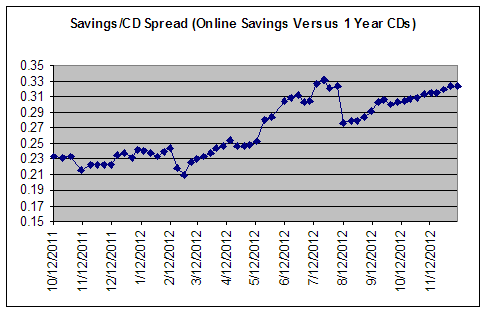Sometimes when I'm looking at data and graphs, I feel like I'm taking a rorschack test. "Go ahead," says the Dr., "look at the image and tell me the first thing that pops into your mind."
So a couple of weeks ago, while I was analyzing the most recent CD and savings rate data, this image popped out of Excel.

It shows that starting in March of 2008 (around the time Bear Stearns failed), we saw a significant widening in the spread between money market accounts and longer term Certificates of Deposit. Or, put another way, the difference between the average yield as calculated by the BestCashCow rate tables on a 3 year CD increased versus the average of all savings accounts listed on the BestCashCow rate tables. This spread reached its peak during the week of October 3 (close to the failures of Lehman, AIG, Fannie, Freddie, etc), at which point it began a precipitous decline. It bottomed out during the week of January 23, the same week as President Obama's innaguration. Since then, it has climbed steadily.and is now almost at the pre-crash range.
So, what does this mean? First, we should put this spread into some context. Rates on deposit accounts (savings, money markets, and cds) have been in a steady decline since the financial failures of late September and early October. Starting in that period, the Fed began a series of rate cuts that brought the Fed Funds rate down from 2% to between 0-.25%. The cut in the Fed rate is responsible for much of the drop in deposit rates. But why the significant changes in the spread?
Here's my rorschack interpretation. From March 2008 to September 2008, consumers, business, and the government was concerned about inflation. Oil peaked at over $140 per barrell last summer amid an enormous commodity bubble. In that environment, long-term rates were higher than short term rates on the expection of further prices increases. Banks needed to compensate consumers more for holding their money for longer periods of time amidst high inflation expectations.
And then all of the bubbles popped at once. Short-term rates fell and so did future expectations of inflation. You and I were willing to lock-in a 3 year CD that wasn't much above the rate on savings accounts because we expected rates to drop and inflation to go down with it. I remember writing a lock-in while you can article last September as the economy began its meltdown and the Fed began slashing.
But in January, the dynamic changed. Rates on longer-term CDs (3+ years) began to fall at a slower rate than the shorter duration deposits. I believe this is because the deposit consumer market began to require a bit more for locking their money up. They began to sense that a new government and all of the stimulus on the horizon was going to begin to untangle the financial mess, stoke inflation, and get the economy moving again. And while the Dow crashed again in late February/March, the spread has continued to widen.
The Treasury bill/paper/bond market had been showing the same widening spread until the Fed announched its intention to purchase Treasury bonds. So, in a sense, the deposit yield curve represents an untampered peak into future inflation expectations.
If this holds up, then it may indeed show that expecations of the economy bottomed sometime in January and that we are beginning the slow climb back. Perhaps the stock market rally is for real and that shifting to a concern of inflation may be prudent.
I'll continue to update the chart and of course, I welcome any comments, feedback, or criticism.













Comments
JDonahue
March 24, 2009
You are making inappropriate inferences from the simple fact that savings rates are falling faster than CD rates.
Is this review helpful? Yes:0 / No: 0
Add your Comment
or use your BestCashCow account